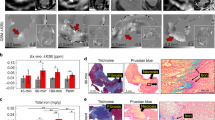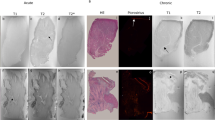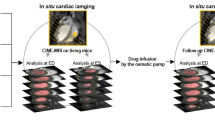Abstract
Utilization of molecular imaging has significantly advanced the field of cardiovascular medicine. In addition to the targets currently in use, novel targets are being developed, including those involved in the processes of myocardial metabolism, myocardial injury, cardiac neurotransmission, and interstitial dysregulation. Further development of these imaging targets may lead to improved characterization of disease processes and guide provision of individualized therapies.
Key Points
-
Molecular myocardial imaging is a rapidly evolving field that aims to provide a better understanding of biologic processes that occur in the myocardium
-
Targeted imaging of myocardial metabolism, myocardial injury, cardiac neurotransmission, and interstitial dysregulation continues to develop, with early incorporation into the clinical realm
-
Identification of novel molecular targets, as well as improvement in the techniques to image currently available targets, is ongoing
-
Limitations of molecular myocardial imaging include low spatial resolution and limited availability of radiopharmaceuticals; further development of the technology should reduce the effect of these limitations
This is a preview of subscription content, access via your institution
Access options
Subscribe to this journal
Receive 12 print issues and online access
$209.00 per year
only $17.42 per issue
Buy this article
- Purchase on Springer Link
- Instant access to full article PDF
Prices may be subject to local taxes which are calculated during checkout




Similar content being viewed by others
References
Neely JR et al. (1972) Myocardial utilization of carbohydrate and lipids. Prog Cardiovasc Dis 15: 289–329
Neubauer S (2007) The failing heart: an engine out of fuel. N Engl J Med 356: 1140–1151
Hosokawa R et al. (1997) Myocardial kinetics of iodine-123-BMIPP in canine myocardium after regional ischemia and reperfusion: implications for clinical SPECT. J Nucl Med 38: 1857–1863
Udelson JE (2006) Diagnosis and risk stratification in acute coronary syndromes. In Atlas of Nuclear Cardiology, ch 8 (Eds Dilsizian V and Narula J) Philadelphia: Current Medicine
Kawai Y et al. (2001) Significance of reduced uptake of iodinated fatty acid analogue for the evaluation of patients with acute chest pain. J Am Coll Cardiol 38: 1888–1894
Wallhaus TR et al. (2001) Myocardial free fatty acid and glucose use after carvedilol treatment in patients with congestive heart failure. Circulation 103: 2441–2446
Nowak B et al. (2003) Cardiac resynchronization therapy homogenizes myocardial glucose metabolism and perfusion in dilated cardiomyopathy and left bundle branch block. J Am Coll Cardiol 41: 1523–1528
Lindner O et al. (2006) Cardiac efficiency and oxygen consumption measured with 11C-acetate PET after long-term cardiac resynchronization therapy. J Nucl Med 47: 378–383
Hofmann M et al. (2005) Monitoring of bone marrow cell homing into the infarcted human myocardium. Circulation 111: 2198–2202
Menasche P et al. (2001) Myoblast transplantation for heart failure. Lancet 357: 279–280
Communal C et al. (2002) Functional consequences of caspase activation in cardiac myocytes. Proc Natl Acad Sci USA 99: 6252–6256
Hirota H et al. (1999) Loss of a gp130 cardiac muscle cell survival pathway is a critical event in the onset of heart failure during biomechanical stress. Cell 97: 189–198
Olivetti G et al. (1997) Apoptosis in the failing human heart. N Engl J Med 336: 1131–1141
Koopman G et al. (1994) Annexin V for flow cytometric detection of phosphatidylserine expression on B cells undergoing apoptosis. Blood 84: 1415–1420
Narula J et al. (2001) Annexin-V imaging for noninvasive detection of cardiac allograft rejection. Nat Med 7: 1347–1352
Hofstra L et al. (2000) Visualisation of cell death in vivo in patients with acute myocardial infarction. Lancet 356: 209–212
Kietselaer BL et al. (2007) Noninvasive detection of programmed cell loss with 99mTc-labeled annexin A5 in heart failure. J Nucl Med 48: 562–567
Kietselaer BL et al. (2004) Noninvasive detection of plaque instability with use of radiolabeled annexin A5 in patients with carotid-artery atherosclerosis. N Engl J Med 350: 1472–1473
Hayakawa Y et al. (2003) Inhibition of cardiac myocyte apoptosis improves cardiac function and abolishes mortality in the peripartum cardiomyopathy of Galpha(q) transgenic mice. Circulation 108: 3036–3041
Donath S et al. (2006) Apoptosis repressor with caspase recruitment domain is required for cardioprotection in response to biomechanical and ischemic stress. Circulation 113: 1203–1212
Li Y et al. (2004) Critical roles for the Fas/Fas ligand system in postinfarction ventricular remodeling and heart failure. Circ Res 95: 627–636
von Harsdorf R (2004) “Fas-ten” your seat belt: anti-apoptotic treatment in heart failure takes off. Circ Res 95: 554–556
James TN (1983) Primary and secondary cardioneuropathies and their functional significance. J Am Coll Cardiol 2: 983–1002
Bristow MR et al. (1992) Beta-adrenergic neuroeffector abnormalities in the failing human heart are produced by local rather than systemic mechanisms. J Clin Investig 89: 803–815
Langer O and Halldin C (2002) PET and SPECT tracers for mapping the cardiac nervous system. Eur J Nucl Med Mol Imaging 29: 416–434
Schwaiger M and Bengel FM (2006) Myocardial innervation. In Atlas of Nuclear Cardiology, ch 11 (Eds Dilsizian V and Narula J) Philadelphia: Current Medicine
Fujimoto S et al. (2004) Usefulness of 123I-metaiodobenzylguanidine myocardial scintigraphy for predicting the effectiveness of beta-blockers in patients with dilated cardiomyopathy from the standpoint of long-term prognosis. Eur J Nucl Med Mol Imaging 31: 1356–1361
Merlet P et al. (1999) Sympathetic nerve alterations assessed with 123I-MIBG in the failing human heart. J Nucl Med 40: 224–231
De Marco T et al. (1995) Iodine-123 metaiodobenzylguanidine scintigraphic assessment of the transplanted human heart: evidence for late reinnervation. J Am Coll Cardiol 25: 927–931
Guertner C et al. (1995) Sympathetic re-innervation after heart transplantation: dual-isotope neurotransmitter scintigraphy, norepinephrine content and histological examination. Eur J Nucl Med 22: 443–452
Estorch M et al. (1999) Sympathetic reinnervation of cardiac allografts evaluated by 123I-MIBG imaging. J Nucl Med 40: 911–916
Goldstein DS et al. (1993) Positron emission tomographic imaging of cardiac sympathetic innervation using 6-[18F]fluorodopamine: initial findings in humans. J Am Coll Cardiol 22: 1961–1971
Goldstein DS et al. (1997) Sympathetic cardioneuropathy in dysautonomias. N Engl J Med 336: 696–702
Orimo S et al. (1999) (123)I-metaiodobenzylguanidine myocardial scintigraphy in Parkinson's disease. J Neurol Neurosurg Psychiatry 67: 189–194
Druschky A et al. (2000) Differentiation of Parkinson's disease and multiple system atrophy in early disease stages by means of I-123-MIBG-SPECT. J Neurol Sci 175: 3–12
Paul M et al. (2006) Impact of sympathetic innervation on recurrent life-threatening arrhythmias in the follow-up of patients with idiopathic ventricular fibrillation. Eur J Nucl Med Mol Imaging 33: 866–870
Schafers MA et al. (2001) Pulmonary beta adrenoceptor density in arrhythmogenic right ventricular cardiomyopathy and idiopathic tachycardia. Basic Res Cardiol 96: 91–97
Parthenakis FI et al. (2002) Segmental pattern of myocardial sympathetic denervation in idiopathic dilated cardiomyopathy: relationship to regional wall motion and myocardial perfusion abnormalities. J Nucl Cardiol 9: 15–22
Lotze U et al. (2001) Recovery of the cardiac adrenergic nervous system after long-term beta-blocker therapy in idiopathic dilated cardiomyopathy: assessment by increase in myocardial 123I-metaiodobenzylguanidine uptake. J Nucl Med 42: 49–54
Matsunari I et al. (2000) Extent of cardiac sympathetic neuronal damage is determined by the area of ischemia in patients with acute coronary syndromes. Circulation 101: 2579–2585
Su H et al. (2005) Noninvasive targeted imaging of matrix metalloproteinase activation in a murine model of postinfarction remodeling. Circulation 112: 3157–3167
Lu E et al. (2003) Targeted in vivo labeling of receptors for vascular endothelial growth factor: approach to identification of ischemic tissue. Circulation 108: 97–103
Cai W and Chen X (2007) Multimodality imaging of vascular endothelial growth factor and vascular endothelial growth factor receptor expression. Front Biosci 12: 4267–4279
Meoli DF et al. (2004) Noninvasive imaging of myocardial angiogenesis following experimental myocardial infarction. J Clin Investig 113: 1684–1691
Sadeghi MM et al. (2004) Detection of injury-induced vascular remodeling by targeting activated alphavbeta3 integrin in vivo. Circulation 110: 84–90
Hua J et al. (2005) Noninvasive imaging of angiogenesis with a 99mTc-labeled peptide targeted at alphavbeta3 integrin after murine hindlimb ischemia. Circulation 111: 3255–3260
Cai W et al. (2007) Dual-function probe for PET and near-infrared fluorescence imaging of tumor vasculature. J Nucl Med 48: 1862–1870
Xie X et al. (2007) Genetic modification of embryonic stem cells with VEGF enhances cell survival and improves cardiac function. Cloning Stem Cells 9: 549–563
Jackson BM et al. (2002) Extension of borderzone myocardium in postinfarction dilated cardiomyopathy. J Am Coll Cardiol 40: 1160–1167
Li Z et al. (2002) Differentiation, survival, and function of embryonic stem cell derived endothelial cells for ischemic heart disease. Circulation 116 (Suppl 11): I46–I54
Acknowledgements
HJC is supported by an SNM Pilot Research Grant.
Author information
Authors and Affiliations
Corresponding author
Ethics declarations
Competing interests
The authors declare no competing financial interests.
Rights and permissions
About this article
Cite this article
Chun, H., Narula, J., Hofstra, L. et al. Intracellular and extracellular targets of molecular imaging in the myocardium. Nat Rev Cardiol 5 (Suppl 2), S33–S41 (2008). https://doi.org/10.1038/ncpcardio1161
Received:
Accepted:
Issue Date:
DOI: https://doi.org/10.1038/ncpcardio1161



